Underwater speakers rely on sound propagation principles to deliver clear audio across aquatic environments. Factors like water temperature, salinity, pressure, and depth influence how sound travels, so proper placement and equipment choice are essential. Secure mounts, ideal positioning, and regular maintenance help guarantee durability and sound quality. Understanding these environmental effects and installation techniques improves performance. If you want to maximize your system and troubleshoot common issues, there’s more detailed guidance to explore.
Key Takeaways
- Underwater speakers should be strategically placed considering water depth, environment, and sound coverage to optimize sound propagation.
- Proper installation involves securing waterproof, corrosion-resistant mounting to prevent vibrations and damage.
- Understanding how temperature, salinity, and pressure affect sound speed guides effective speaker placement.
- Selecting the right type of speaker (hydrophone or long-throw) depends on specific application goals.
- Regular maintenance and inspection are essential to ensure optimal sound quality and system longevity underwater.
Fundamentals of Underwater Sound Propagation

Understanding how sound travels underwater is essential for designing effective underwater speakers. Unlike in air, sound moves faster and over longer distances in water because of its higher density and elasticity. When you generate sound waves, they propagate as compressional waves through the water, bouncing off objects and spreading out in all directions. The speed of sound in water typically averages around 1,500 meters per second but can vary depending on temperature, salinity, and pressure. These factors influence how sound waves bend and how far they travel before losing energy. Recognizing these basics helps you optimize speaker placement and frequency choices, ensuring your sound reaches the intended area clearly and efficiently. Understanding sound propagation is crucial for achieving optimal sound quality and coverage in underwater environments, especially considering how environmental conditions can impact sound transmission. Additionally, considering sound attenuation helps in adjusting for energy loss over distance, further improving sound clarity and range.
Characteristics of Acoustic Waves in Aquatic Environments

Acoustic waves in aquatic environments exhibit unique characteristics that influence how sound is transmitted and received underwater. Unlike in air, sound travels faster and over longer distances due to water’s higher density and elasticity. You’ll notice that lower frequencies tend to propagate farther, while higher frequencies are absorbed more quickly. Water’s temperature, salinity, and pressure impact how sound waves behave, affecting their speed and attenuation. Acoustic waves often bend or refract as they move through layers with different properties, altering their paths. You’ll also observe that sound waves can reflect off surfaces like the seabed or underwater structures, creating echoes. Recognizing these traits helps you understand how to optimize speaker placement and maximize sound clarity in underwater environments. Additionally, sound absorption varies with water conditions, influencing how effectively sound transmits over distance. Variations in sound speed caused by temperature and salinity gradients further complicate sound propagation, requiring careful analysis for optimal performance.
Factors Affecting Sound Transmission Underwater
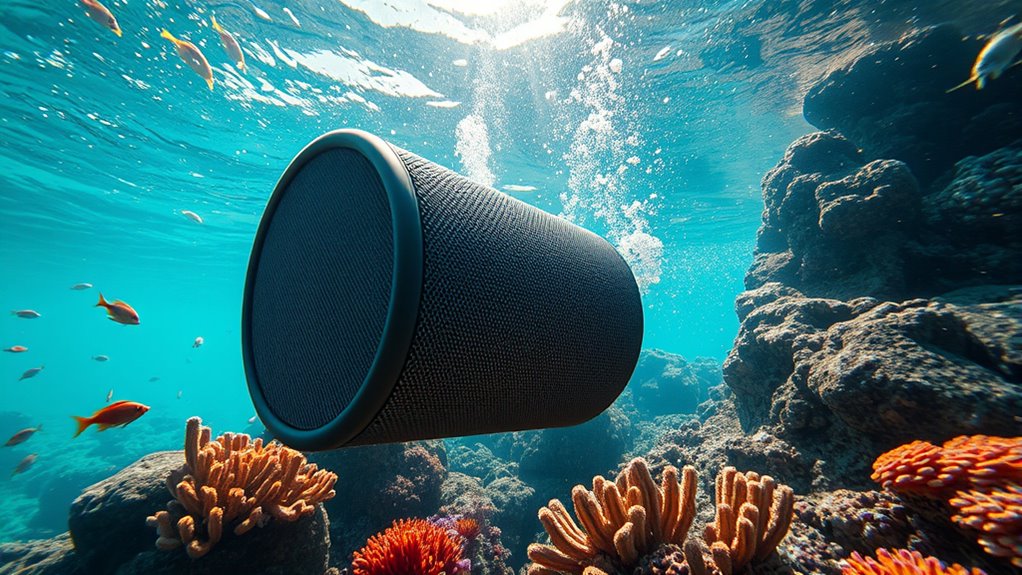
You’ll notice that water temperature and pressure greatly influence how sound travels underwater. As temperature changes, it affects the speed and clarity of audio signals, while increasing depth and pressure can alter sound waves’ behavior. Understanding these factors helps you optimize underwater speaker performance in different environments. Additionally, the role of sound waves in transmitting audio efficiently is crucial for effective underwater sound systems. To further improve sound transmission, selecting appropriate audio frequency ranges can significantly impact clarity and range in various conditions. Moreover, sound propagation varies based on environmental conditions, requiring tailored speaker designs for specific settings. Recognizing the impact of environmental variables such as salinity and water movement can also enhance the reliability of underwater audio systems. Incorporating mindfulness techniques can also enhance focus during installation and maintenance tasks, ensuring optimal setup and operation of underwater audio systems.
Water Temperature Variations
Water temperature plays a crucial role in how sound waves travel underwater. When water is warmer, sound speeds up because molecules move more quickly, allowing sound to travel farther with less energy loss. Conversely, in colder water, sound slows down, reducing its transmission distance. Temperature variations can create layers within the water, causing refraction or bending of sound waves, which affects how sound propagates. These differences can cause sound to focus or scatter, impacting the clarity and range of underwater communication or recordings. If you’re installing underwater speakers, understanding temperature profiles helps optimize placement and minimize signal loss. Additionally, regional variations in water temperature can significantly influence sound behavior, making it essential to monitor these fluctuations regularly for reliable sound transmission. Recognizing how sound speed varies with temperature can aid in more accurate predictions of sound propagation paths and improve overall system performance. Moreover, sound refraction caused by temperature gradients can lead to unexpected dead zones or enhanced transmission areas, which are important to consider during system design. Being aware of thermal layers can help in adjusting speaker placement to maximize sound clarity and reach.
Depth and Pressure
As you consider installing underwater speakers, understanding how depth and pressure influence sound transmission becomes essential. As you go deeper, water pressure increases, which can affect how sound waves travel. Higher pressure compresses sound waves, causing them to lose energy faster and reducing their range. Additionally, deeper waters often have different acoustic properties, such as increased density and decreased temperature, which can further impact sound clarity and reach. You’ll need to select speakers that can withstand the pressure at your desired depth without distortion or damage. Proper installation guarantees sound waves propagate efficiently, maintaining clarity and volume. The changing conditions at different depths also affect sound propagation, helping you optimize speaker placement, ensuring your sound system performs reliably across various depths and conditions. Recognizing sound transmission factors is critical for achieving optimal sound quality underwater. Regular maintenance and inspections can ensure your appliance remains in top condition, especially in challenging environments. Being aware of acoustic properties enables better prediction of how sound behaves in different underwater environments. Additionally, understanding pressure effects on sound can help in designing more durable and effective underwater audio systems.
Types of Underwater Speakers and Their Applications
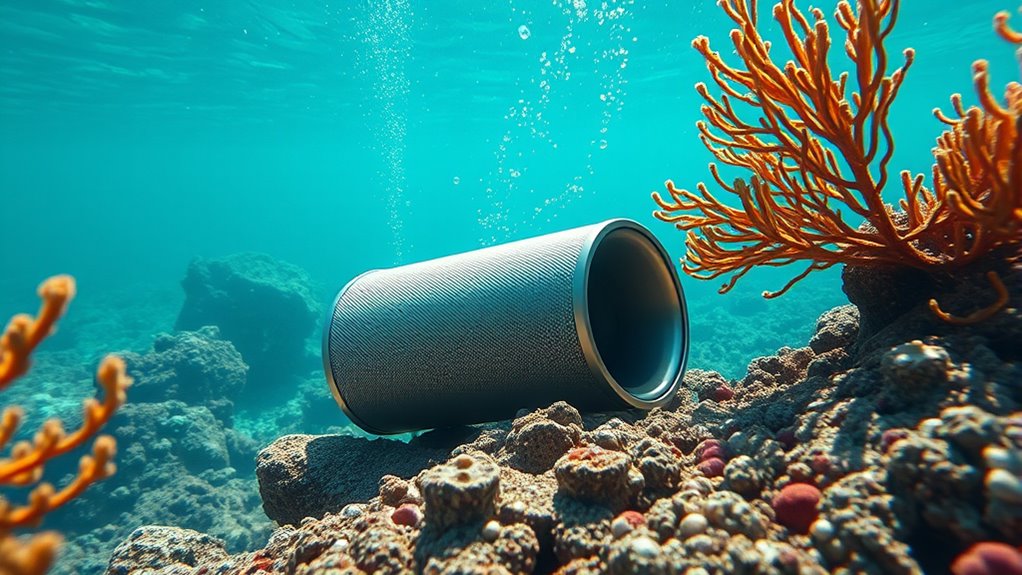
Have you ever wondered how sound travels so effectively underwater? Different types of underwater speakers are designed to optimize this transmission for various applications. Conventional electrodynamic speakers produce broad sound coverage, perfect for marine research or underwater alerts. Piezoelectric speakers are compact and durable, making them ideal for diver communication systems and small-scale applications. Hydrophones, technically microphones, are used for listening and recording underwater sounds, such as marine life or vessel activity. In contrast, specialized long-throw speakers deliver high volume over long distances, suitable for public address systems at aquariums or marine parks. Each type serves a distinct purpose, ensuring you can select the right speaker based on your specific needs—whether for communication, research, or entertainment underwater. Additionally, AI technology plays a significant role in optimizing sound propagation and analysis in underwater environments, and understanding sound propagation principles is essential for effective speaker deployment. Recognizing sound wave behavior can greatly improve the placement and performance of these speakers in various underwater settings. Moreover, an understanding of diving safety considerations can help prevent damage to equipment and ensure the safety of operators during installation and maintenance. Proper knowledge of underwater acoustics can also aid in designing more efficient and effective sound systems for marine applications.
Designing an Effective Underwater Sound System

To design an effective underwater sound system, you need to focus on ideal speaker placement to guarantee even sound distribution. Improving sound quality involves selecting the right equipment and adjusting settings for clarity and volume. Additionally, understanding sound propagation in water is crucial for optimizing speaker positioning and ensuring consistent audio coverage beneath the surface. Recognizing how narcissistic traits influence behavior can help in managing complex relationships with narcissists who may manipulate or undermine sound systems for personal gain. By paying attention to these points, you’ll create a more immersive and effective listening experience beneath the surface.
Optimal Speaker Placement
Choosing the right placement for underwater speakers is essential to ensuring clear, even sound distribution across the targeted area. Start by mapping out the space to identify key zones where sound coverage is most needed. Position speakers at strategic points, ideally at equal distances from each other, to prevent sound gaps or overlapping signals. Consider the depth of installation; placing speakers too deep can weaken sound, while too shallow might cause interference. Mount them securely to minimize vibrations that could distort sound. Keep in mind obstacles like rocks or submerged structures that can block or reflect sound waves. Testing different positions before final installation helps optimize coverage and prevents future adjustments. Proper placement maximizes sound clarity, ensuring your underwater sound system performs effectively.
Sound Quality Optimization
Designing an effective underwater sound system requires careful attention to the quality of the audio output. To optimize sound quality, select high-quality, waterproof speakers that deliver clear, consistent sound across the desired frequency range. Guarantee your system is properly sealed to prevent water intrusion, which can distort audio. Adjust the power levels to avoid distortion or muffling, especially at higher volumes. Use sound-dampening materials around the speakers to minimize vibrations and unwanted noise. Conduct thorough testing in your environment, noting how sound propagates and adjusting placement accordingly. Regular maintenance, such as cleaning and inspecting connections, keeps the system performing at its best. By focusing on these details, you’ll ensure your underwater sound system provides clear, immersive audio experiences.
Installation Considerations for Underwater Speakers
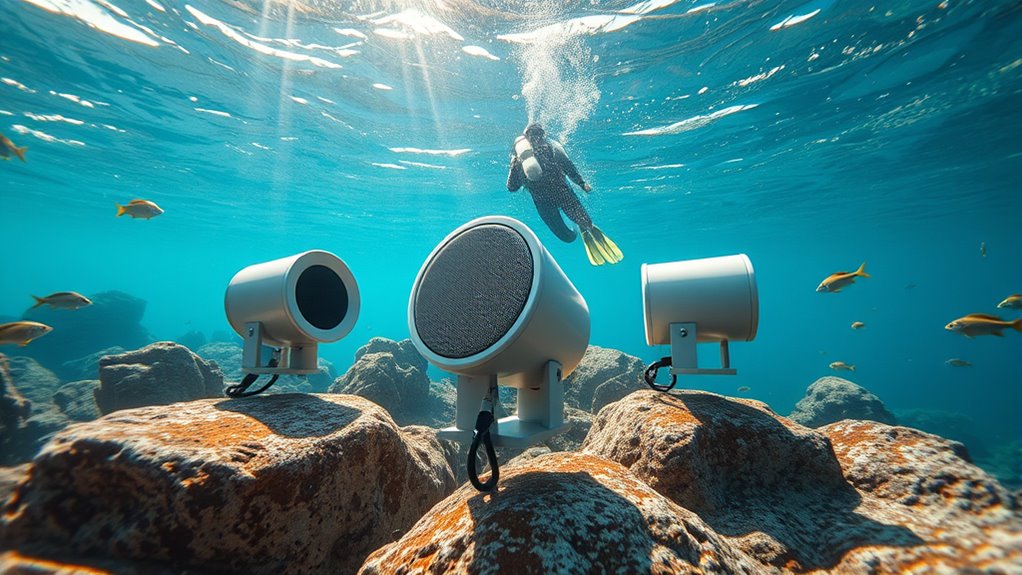
Installing underwater speakers requires careful attention to placement to guarantee ideal sound quality and durability. You need to take into account factors like depth, proximity to surfaces, and environmental conditions. Proper mounting ensures the speakers stay secure despite water currents and weather changes.
Installing underwater speakers demands careful placement for optimal sound and durability.
Keep these points in mind:
- Choose locations that minimize interference from obstacles or debris
- Ensure the mounting surface is stable and corrosion-resistant
- Avoid placing speakers too close to the water’s surface or bottom to prevent sound distortion
Techniques for Optimal Placement and Orientation
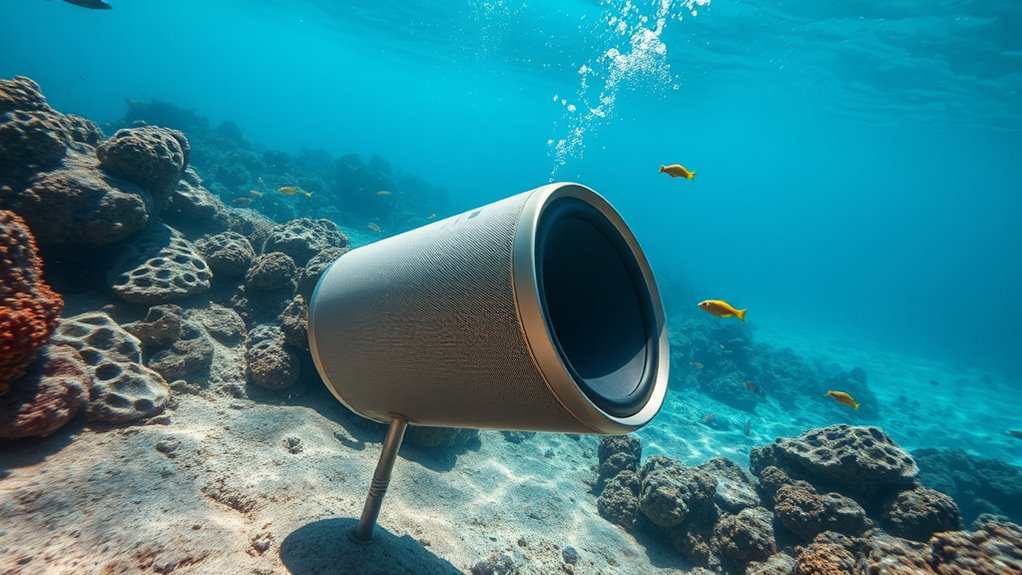
To get the best sound coverage, you need to ensure the right depth and how to position your speakers effectively. Aligning them directionally ensures the sound reaches your target area without distortion or loss. Keep environmental factors like water currents and obstacles in mind to optimize performance and longevity.
Depth and Depths
Have you ever wondered how the depth at which an underwater speaker is placed affects its sound projection? Depth influences how far and clearly sound travels through water. Placing the speaker too shallow can cause sound to reflect off the surface, reducing clarity. Conversely, too deep can dampen sound levels and reduce reach. To optimize performance, consider these factors:
- Position the speaker at a depth where sound waves can propagate with minimal interference.
- Avoid obstructions like rocks or debris that can block or distort sound.
- Ensure the speaker is stable and securely mounted to prevent movement that could alter sound direction.
Selecting the right depth helps maximize sound coverage, clarity, and efficiency, ensuring your underwater audio setup performs at its best.
Directional Alignment Strategies
Achieving ideal sound projection underwater requires careful attention to the speaker’s orientation. You should aim to direct the speaker’s output toward your target area, minimizing energy loss and ensuring clear transmission. Use adjustable mounting brackets to fine-tune the angle precisely. Position the speaker so its primary sound beam aligns with the intended listening zone, avoiding obstructions that could cause reflections or distortions. Take advantage of directional speakers to focus sound waves and reduce unwanted noise dispersion. Regularly verify the alignment with underwater acoustics tools or sonar measurements, especially after installation or movement. Proper orientation not only enhances sound quality but also maximizes efficiency, ensuring your underwater audio setup delivers consistent, targeted performance.
Environmental Considerations
Choosing the right placement and orientation of underwater speakers is essential for ideal sound delivery, especially considering the surrounding environment. To minimize disruptions and maximize efficiency, you should evaluate factors like nearby structures, marine life, and water currents. These elements influence sound propagation and can cause unwanted reflections or attenuation.
Consider these key techniques:
- Position speakers away from sensitive habitats to avoid disturbance
- Orient them to direct sound toward your target area, reducing interference
- Mount speakers securely to prevent movement caused by currents or animals
Maintenance and Durability of Underwater Audio Equipment
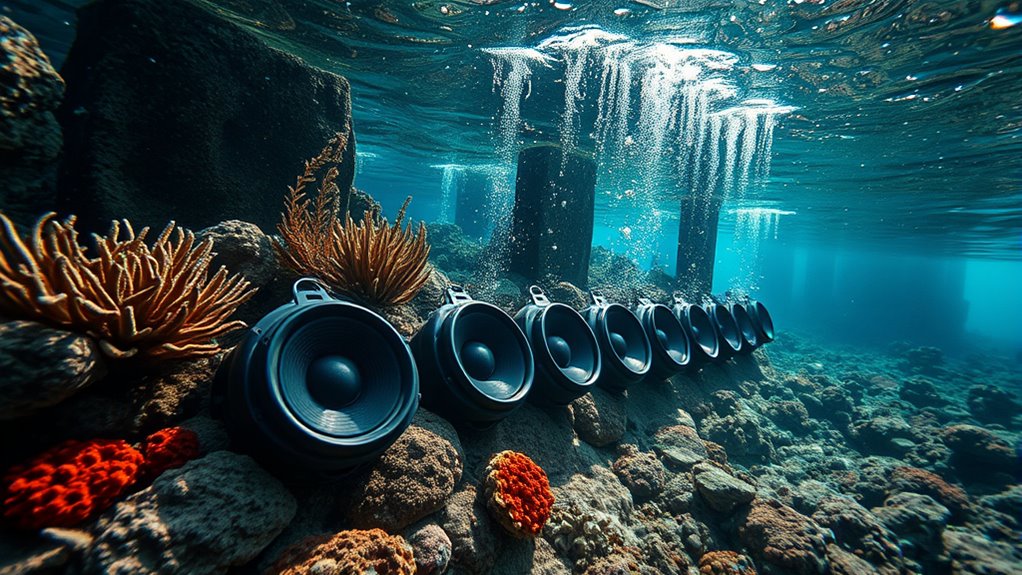
Maintaining underwater audio equipment requires regular inspection and careful handling to guarantee it remains functional in harsh aquatic environments. You should routinely check for signs of corrosion, especially on metal parts, and ensure seals remain intact to prevent water ingress. Cleaning equipment with fresh water after use helps remove salt, algae, and debris that can degrade components. Protect sensitive parts by applying corrosion-resistant coatings or enclosures designed for underwater use. Proper installation also plays a role; ensure cables and connectors are secure and free from damage. Regular maintenance extends the lifespan of your equipment and preserves sound quality. Keep detailed records of inspections and repairs to identify recurring issues. Investing in durable, high-quality materials from the start reduces long-term costs and enhances equipment resilience.
Troubleshooting Common Underwater Sound Issues
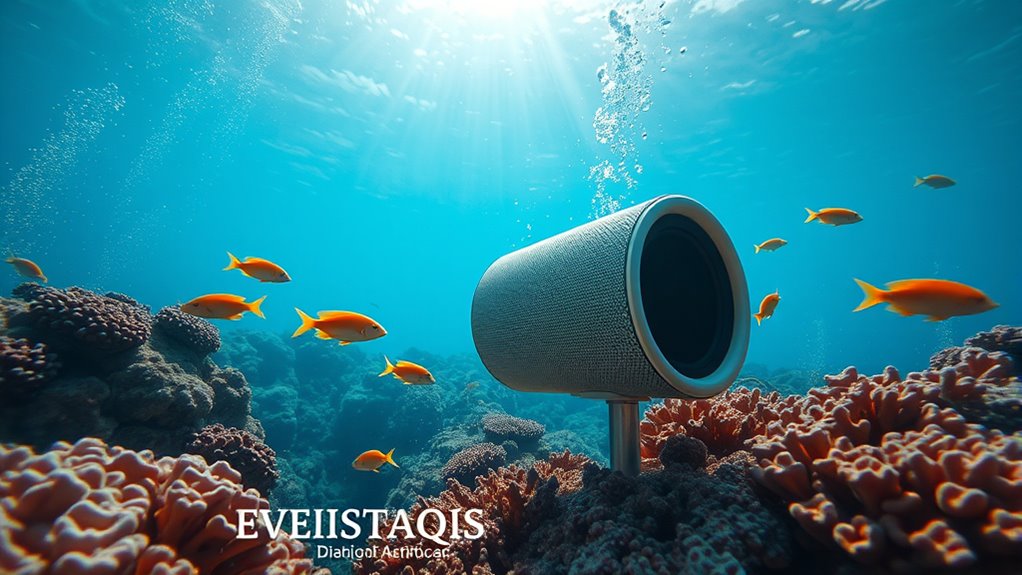
Even with proper maintenance, underwater audio equipment can encounter sound issues that disrupt performance. When you face these problems, start by checking connections for corrosion or looseness, as these are common causes. Next, inspect the speaker’s placement; improper positioning can lead to weak or distorted sound. Finally, verify the power supply and signal source to guarantee they’re functioning correctly. Common issues include muffled audio, inconsistent output, and background noise. To troubleshoot effectively:
- Clean and tighten all connectors and contacts
- Adjust the speaker’s position for ideal sound propagation
- Test the power supply and replace faulty cables or components
Future Trends in Underwater Acoustic Technology

Advancements in underwater acoustic technology are poised to revolutionize how you explore and monitor the aquatic environment. You’ll see more precise, high-resolution sensors that improve sound detection and communication over greater distances. AI and machine learning will enable real-time data analysis, helping you identify patterns and anomalies faster. Future devices will likely be smaller, more energy-efficient, and easier to deploy, making long-term monitoring more practical. Adaptive sound transmission techniques will optimize sound propagation based on environmental conditions, enhancing clarity and reducing noise interference. Additionally, integration with autonomous underwater vehicles (AUVs) will expand your ability to gather data in challenging or previously inaccessible areas. These innovations will deepen your understanding of marine ecosystems, improve resource management, and bolster underwater security efforts.
Frequently Asked Questions
How Do Underwater Currents Affect Speaker Placement?
You might wonder how underwater currents influence speaker placement. Currents can shift or destabilize speakers over time, affecting sound quality and coverage. To counter this, you should secure your speakers firmly and choose locations with minimal current flow. Regularly check and adjust their positioning as needed. By understanding current patterns, you ensure your speakers remain effective, delivering clear sound even in dynamic underwater environments.
What Safety Precautions Are Necessary During Installation?
When installing underwater speakers, safety precautions are vital. You should wear appropriate protective gear, like gloves and waterproof clothing, to prevent injury from sharp objects or electrical hazards. Make sure to turn off power sources before installation, and guarantee all equipment is properly grounded. Use safety ropes and buoys to secure equipment, and work with a team to avoid accidents. Always follow manufacturer instructions and local safety regulations for a safe setup.
How Do Marine Life Interactions Impact Speaker Performance?
Sure, marine life’s curious nature can surprisingly boost your speaker’s performance—if you see it as a challenge. Their presence might cause sound scattering or absorption, reducing clarity and range. Ironically, while they’re just trying to explore or communicate, they interfere with your setup. You’ll need to account for these interactions, perhaps by adjusting frequencies or placement, to guarantee your underwater sound stays clear despite their unintended role in your aquatic environment.
Can Underwater Speakers Be Integrated With Other Marine Systems?
You can definitely integrate underwater speakers with other marine systems. Doing so allows you to create a cohesive environment, enhancing communication, navigation, and entertainment. Make certain to choose compatible hardware and plan for proper installation to prevent interference or damage. By coordinating with existing systems like sonar, communication networks, or monitoring devices, you optimize performance and ensure reliable operation across your marine setup.
What Are the Environmental Considerations for Underwater Speaker Use?
Imagine serenading the ocean’s inhabitants with your tunes, only to realize you’re disturbing their peaceful abyss. You should consider noise pollution, which can harm marine life and disrupt ecosystems. Choose eco-friendly equipment, keep volumes reasonable, and avoid sensitive breeding periods. By respecting these environmental considerations, you help maintain ocean health while enjoying your underwater soundscape, proving you’re not just a loudmouth but an eco-conscious explorer.
Conclusion
As you navigate the depths of underwater sound, remember that the right choices in installation and maintenance can turn your aquatic space into a symphony of clarity. With careful placement and thoughtful design, you’ll create an environment where sound flows seamlessly like gentle waves caressing the shoreline. Embrace the evolving technology, and you’ll find your underwater soundscape blossoming into a vibrant, immersive experience, whispering secrets that only the water can truly understand.










